The War of the Fifth Coalition is fascinating in its scope. Aspern-Essling and Teugn-Hausen come to mind immediately but these two famous battles (in wargaming circles at least) already overshadow Eckmühl. Then there are the other theaters like Italy and Poland where battles happened at about the same time. Lets just look at the month of April in 1809:
- 15-16 April 1809 – Battle of Sacile (Italy)
- 19 April 1809 – Battle of Teugen-Hausen (Bavaria)
- 19 April 1809 – Battle of Raszyn (Poland)
- 20 April 1809 – Battle of Abensberg (Bavaria)
- 21 April 1809 – Battle of Landshut (Bavaria)
- 22 April 1809 – Battle of Eckmühl (Bavaria)
- 23 April 1809 – Battle of Ratisbon (Regensburg)
- 24 April 1809 – Battle of Neumarkt-Sankt Veit (Bavaria)
- 25 April 1809 – Battle of Radzymin (Poland)
- 27-30 April 1809 – Battle of Caldiero (Italy)
Quite a tally. Unsurprisingly this post is about Raszyn, where France’s Polish allies took a stand against the Austrian thrust on Warsaw. The mighty ally was more than busy in Bavaria, as can be seen by the timeline. So the Poles had to fight on their own against 2:1 odds. The able Poniatowski did an admirable job against his doubtful counterpart Archduke Ferdinand, but strategically Austrian numbers prevailed.
Deployment
Let us see how I fare in this scenario. All descriptions under the images. Figures are 6mm Baccus. I used French miniatures for the Poles and Saxons. The game is scaled from 1 inch per Age of Eagles and scenario rules to 1.5 cm on my table.
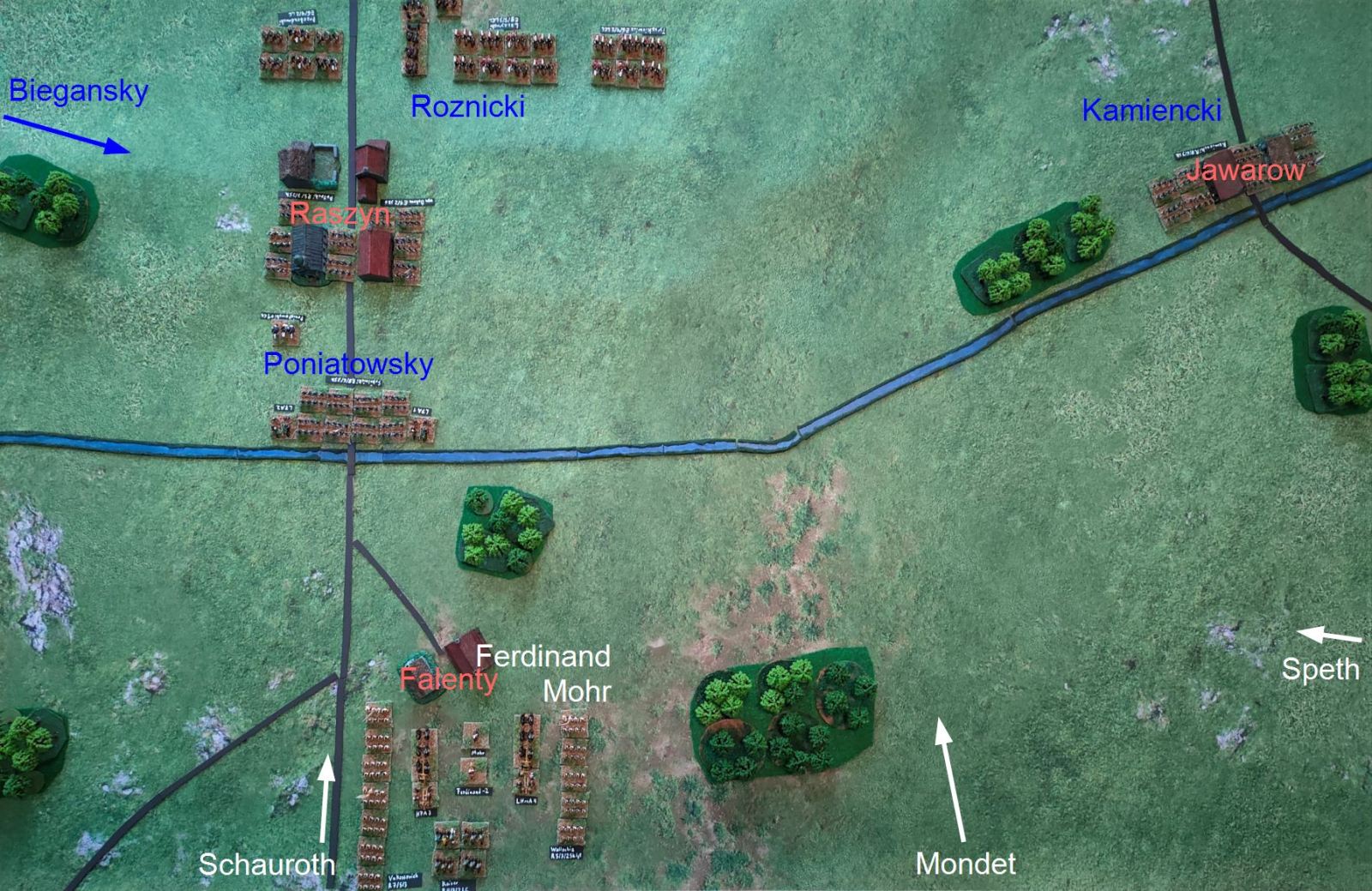
Poniatowsky has chosen a good defensive position at Raszyn, which protects the road to Warsaw. The stream is only fordable by infantry and is marshy for a couple of inches/cm on both sides (not depicted). Austrians who manage to get past this obstacle have to deal with defenders in Raszyn and on the hills to the east and west of it. The arrows shows arrival of reinforcements in the coming hours.
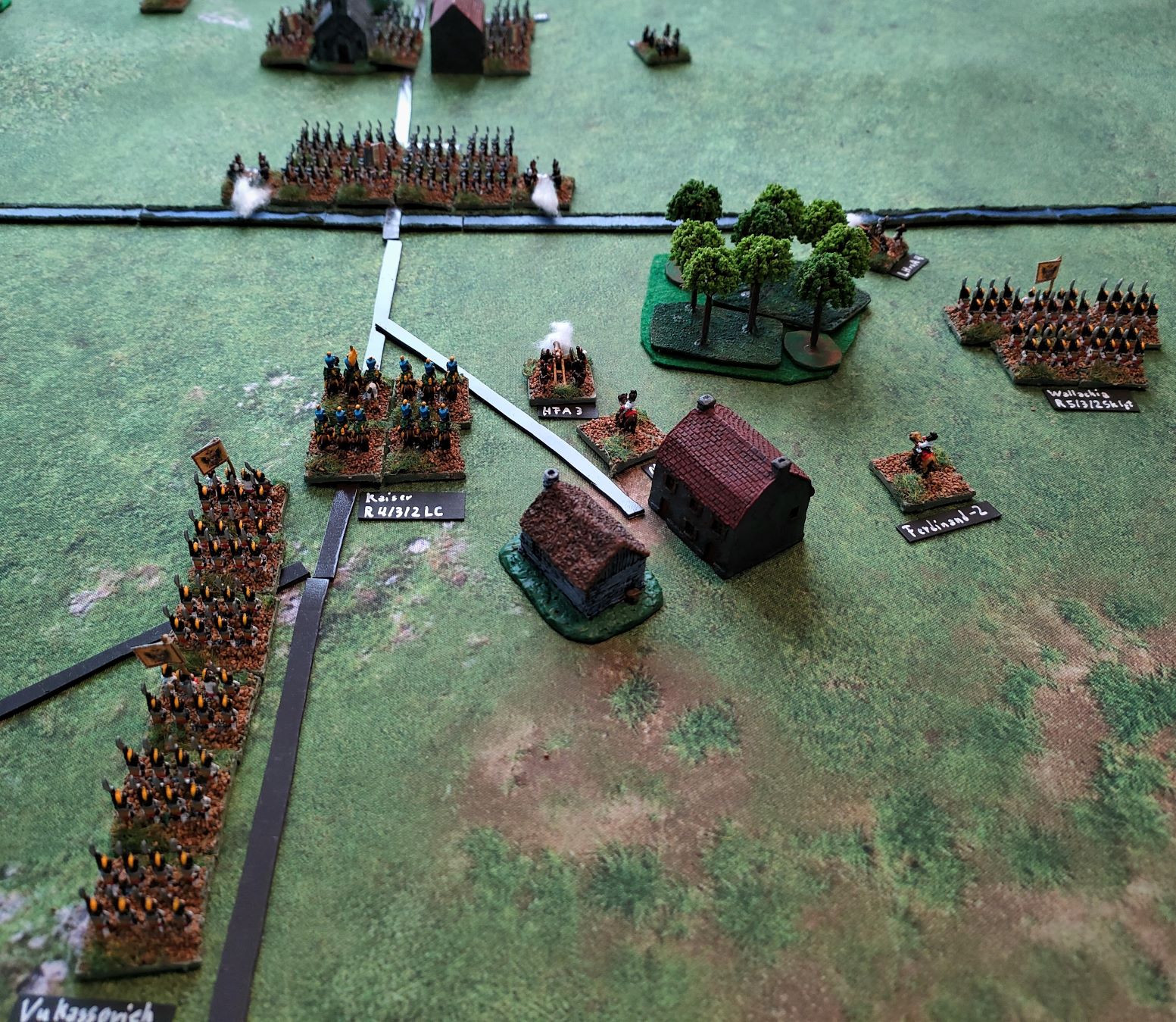
02:30 pm – Sokolnicki’s brigade has a strong defensive position across the stream with supporting artillery. The Austrians have a rough start as their deployment is hampered by effective artillery fire.

04:00 – Schauroth’s cavalry and much needed artillery slowly arrive at the scene. Vukassovitch finally managed to get his brigade in formation for the first attack.

04:00 – Mendet arrives with the bulk of his large division. He is already over an hour late by this point.
Sidenote – Reserve Movement
A complex part of Age of Eagles, as the authors confess themselves, is reserve movement. You have to roll for maneuvers to happen and disruption to be removed for every brigade, but if the enemy still far away brigades roll on a different table with another long list of modifiers. These represent the difficulties to deploy reserves in the period, especially for the enemies of France and less able generals & staff.
Reserves deserve attention in wargaming, there is not doubt about it, but the modifiers and constant measuring and turn order of reserve movement / normal movement is taxing and frustrating at times. Especially as there are only few but important rolls to make. Lady Luck is fickle in such matters. I failed most of these rolls several turns in a row. Granted, the odds will get progressively better. Still, the Austrians were generally 1-2 hours late for everything. Such tardiness is not unheard of and makes for an interesting story. It is just not satisfying when you roll badly 2 times for a brigade and you know that 4.600+ men will never be able to do anything within the turn limit of the scenario.
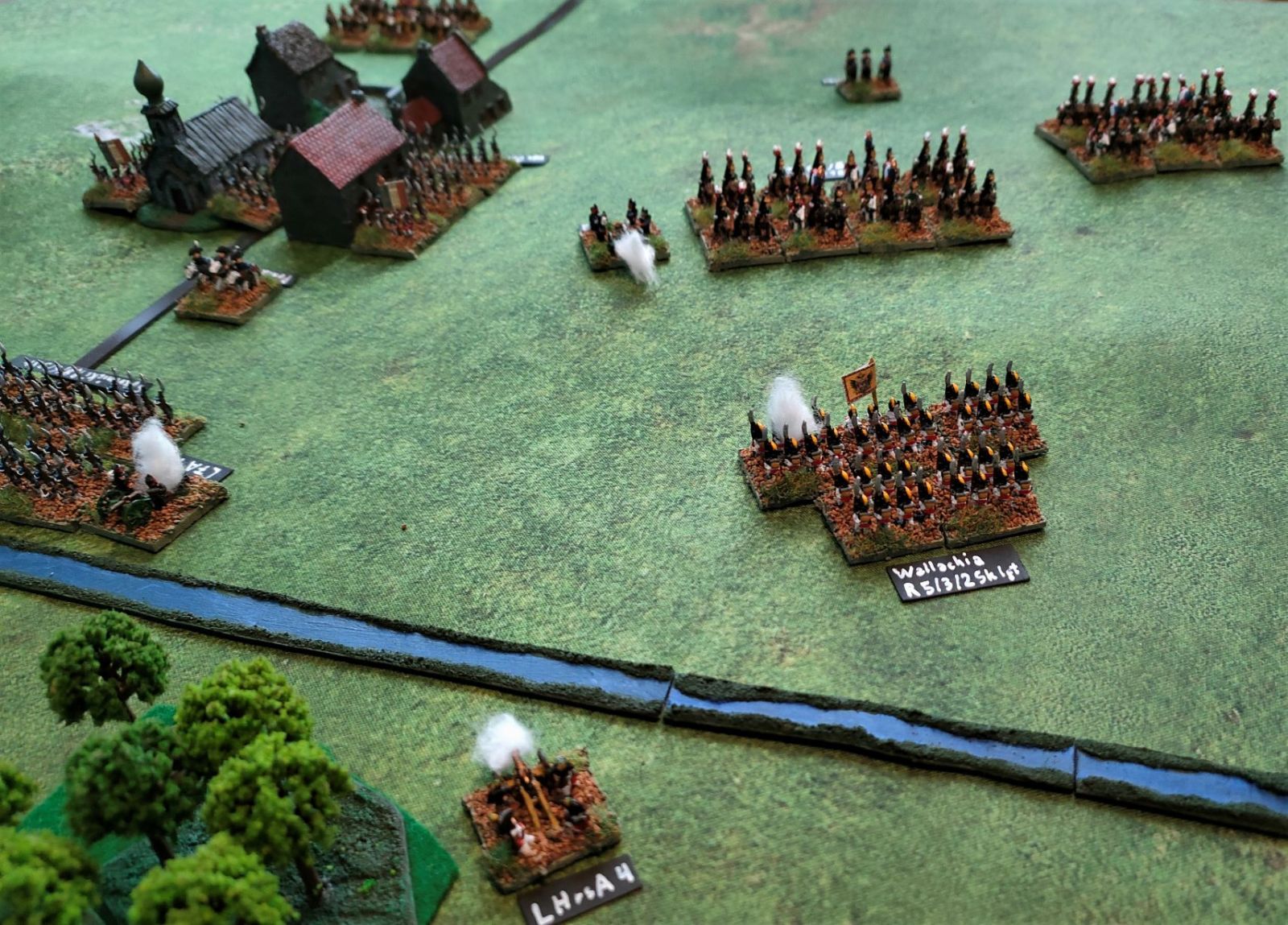
04:00 – A brigade that managed to do a lot was Wallachia’s. The Austrians navigated the marshland and stream to establish an early beachhead (more like marshhead) for Mondet’s men to exploit.
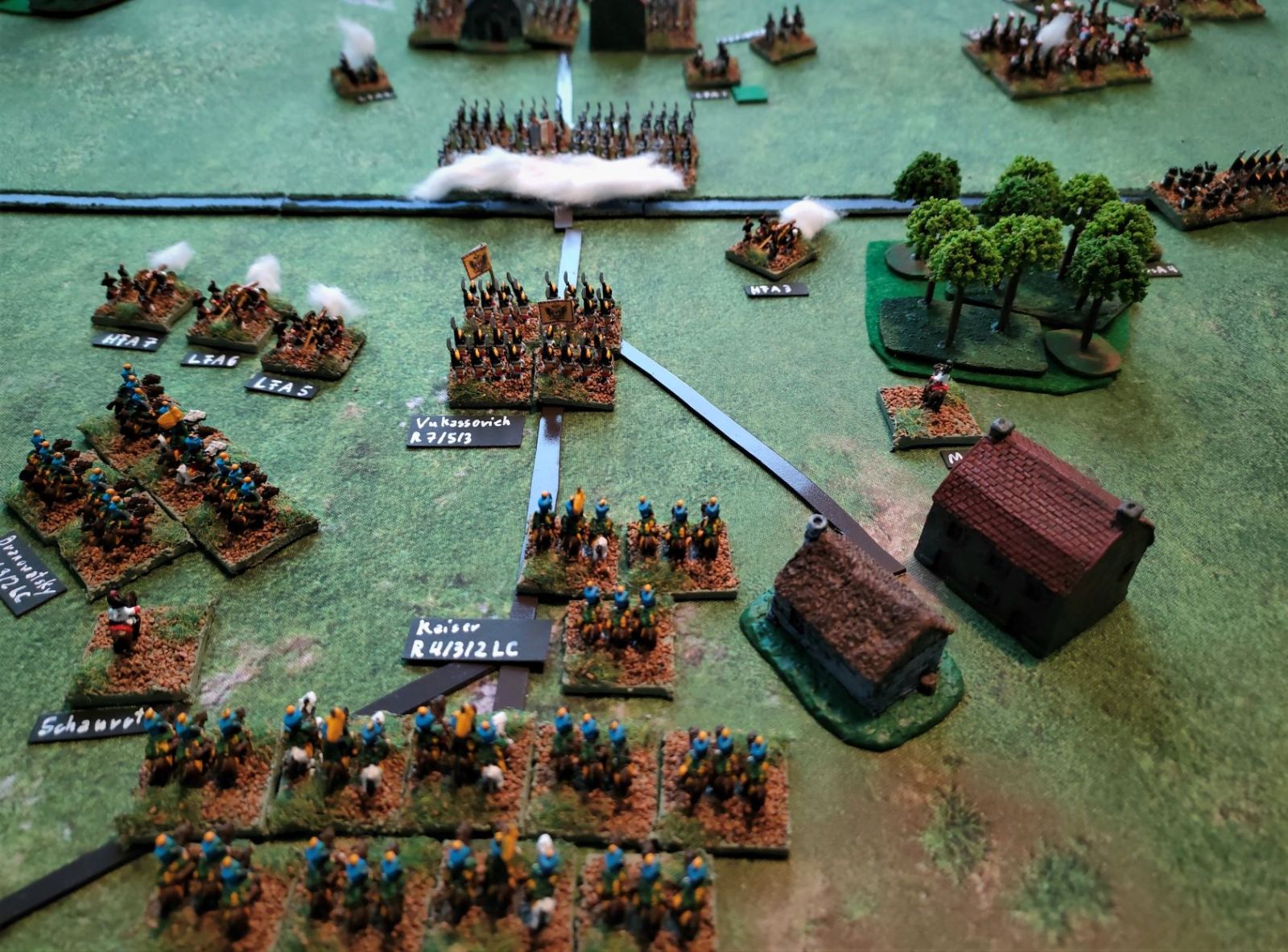
05:00 – Vukassovitch’s attack across the bridge has been beaten back with heavy losses. Archduke Ferdinand orders Schauroth’s division of Hussars to prepare for an attack. His artillery begins to soften up the Poles and Gehringer’s men (bottom) are ready to go.

05:00 – In the center Wallachia’s brigade has been pushed back across the stream but Mondet’s men are now in a good position to carry the attack forward by sheer manpower. On the right Speth’s heavy cavalry makes ready for an attack if the artillery can soften up the Polish defenders.

06:00 – Thousand’s of men stream across the marshes and up the hill. Roznicki skillfully retires to make a concerted attack possible and give the reinforcements time to catch up. Poniatowski’s sends Saxon grenadiers under von Dehrrn to this sector as well (just barely visible in the upper left). It looks like the battle of Raszyn will be decided here.
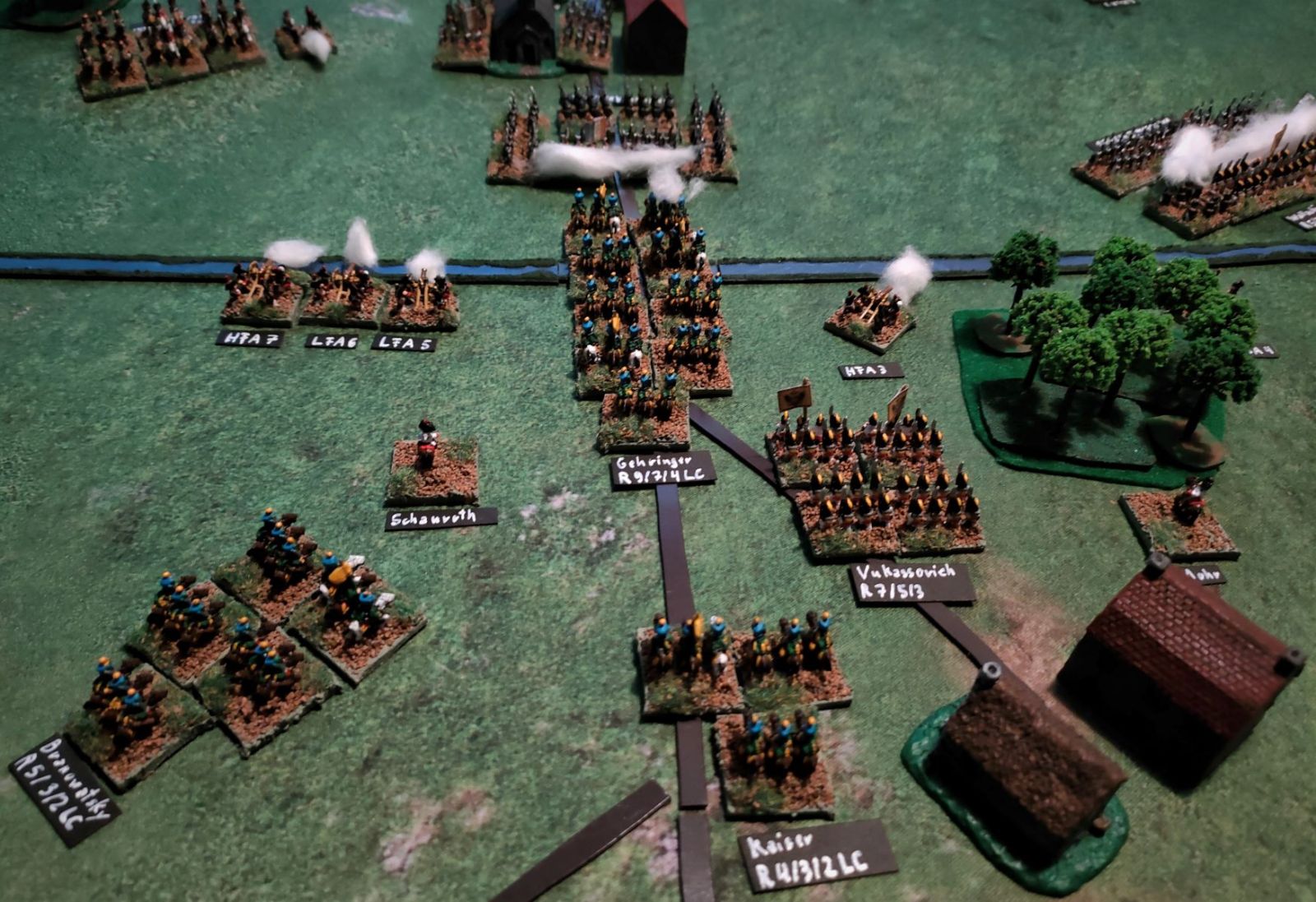
06:30 – First, though, Gehringer’s charge goes in. Sokolnicki’s brigade holds the Hussars off for long enough to form a number of squares. The Austrians have to retire and reform.

06:30 – Meanwhile the center becomes a cauldron of steel and fire. Von Dehrrn Saxons keep Wallachia occupied (left) while massed Polish lancers charge The Austrians in front of them. Poniatowksi and Roznicki are both leading riders to the charge. It hits home with huge force and drives the enemy back with heavy losses. The bad news for Mondet do not stop at this point. The Polish are invigorated by their victory and keep on charging at Pflacher’s already diminished brigade. Men are cut to pieces left and right as they try to flee from the riders but are hindered by the marshy ground. Battalion after battalion breaks and the entire brigade disintegrates right in front of Mondet’s eyes. Trauttenberg’s men and rough ground finally hold the charge.

07:00 – Roznicki’s lancers and the Saxon charge again but the Austrians are prepared. Trauttenbergs beats the attack back on the right. Meanwhile Wallachia’s battalions greet the Saxons with telling fire and absolutely destroy the few battalions that come close. Von Dehrrn’s brigade breaks. Wallachia stops his men from pursuing and orders the formation of squares immediately. Another example of Austrians being quite adept if upper leadership doesn’t interfere too much.

07:00 – The battle is over. As can be gathered from the white lines Austrian footholds across the stream are tenuous. Losses are also far worse for the Austrians. Their numerical superiority is still intact and they would probably crack the defense eventually. What has been missing from this simulation is the effect of thousands of Austrians fleeing in panic as Pflacher’s brigade broke. I think such a situation would caused havoc on the other brigades behind Pflacher at this moment. In fact it probably would have been the battle ending moment. So for this day, Poniatowski defended to gates of Warsaw.
Conclusion
As I indicated in the sidenote, failing critical rolls robbed the Austrians of valuable time to push the enemy within the given time frame. I could have played 1-2 turns longer of course, but was tired of the scenario though. A day earlier I tried to play it with Snappy Nappy and had to end it a couple turns in. It simply didn’t work and was no fun at all. Both playthroughs shared the problem of high randomness due to few key dice rolls. This is not a slight on either system. I have to give Snappy Nappy another proper go before I add it to the rules review page. As a representation of the battle, AOE actually worked well. There were many challenges to face for the Austrians. It just was an uphill battle to get all the rules back into my skull and frustrating to see formations fail to move over and over again.
I think the key roll issue stems from the relatively small size of the scenario compared to the grand tactical scope of the rules played. Additionally AOE and Snappy Nappy are games with relatively few dice rolls. Mechanics resting on a lot of dice rolls might seem gamey to some but they achieve an important goal in averaging out the randomness.

Very interesting, thanks. I take the point about frustration over formation release, though I tend towards indulging such chaos as anything that puts the hand of restraint on the shoulder of a gamer to remove too much control is attractive to me. I am increasingly feeling though that I want my games to be easier to play and get to the table.
LikeLiked by 1 person
Thanks Norm. I’m with you on the chaos aspect. Usually I tend to enjoy friction and chaos on the table. But I have a lot of that in my real life at the moment, so maybe that is why I would have liked for everything to work out in the game. Maybe we wargamers are humans after all 😉
A game being easy to set up and play is very nice indeed. But if it’s a simple pick up game with a familiar rule set and no history, it runs the danger of being bland. It’s a difficult balance I guess.
LikeLike
Yes, I think for the simpler games, we are relying on a good quality scenario to give us that necessary mental engagement. The balancing point is a fluid thing that is likely in a different place for many of us, for a variety of reasons. It is indeed a rich tapestry of interest. 🙂
LikeLiked by 1 person